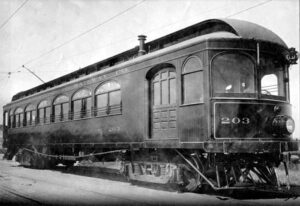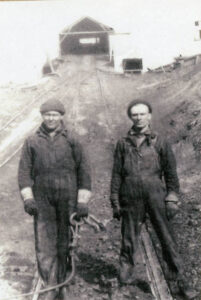Litchfield, Kansas was a busy coal-mining town on Carbon Creek in Crawford County. At one point, it was shipping about 500 carloads of coal each month.
The community was first named Edwin in honor of Colonel Edwin Brown. On January 31, 1878, a post office was established with Jeff Bedford as the postmaster. Bedford and Jim Whitfield soon sunk a coal shaft. At that time, Edwin and nearby Pittsburg were rival coal camps and were about the same size. However, Edwin was more important, as mining operations were being conducted all along the creek, while Pittsburg had only one shaft.
The Joplin Railroad Company built a spur north to the mining camp. Edwin Brown soon brought Jack Armel, a railroad contractor, to Carbon Creek, and Armel leased the land where Jeff Bedford had put down his shaft. Armel then sent to Ohio for a couple of young men named James A. Patmor and his brother Charles. The Patmor brothers brought back a steam shovel and began stripping north of Edwin. The Patmor brothers were soon getting out a large quantity of coal with their steam shovel. Charles Patmor also opened the first coal pits at Midway about this time.
In the meantime, Peter Coyle, the active manager of the Coyle coal business, died, and his business was sold to capitalists in Oswego, Kansas, who formed the Oswego Coal Company. This company began extensive operations at Edwin in the spring of 1880 and sunk a second shaft, known as No. 2, about 3/4 mile from Litchfield. That winter Bill Weaver took a contract to build 28 company houses in the camp for the Oswego Coal Company. A company store was also built.
The same year, T. R. Jones and David Arnott sunk a gin shaft at Edwin that was known as No. 5.
On May 9, 1881, the town and post office names were changed to Litchfield. At that time, it boasted a post office, public school, a general store, a drug store, two blacksmith shops, a wagon shop, and about 200 people.
When the St. Louis and San Francisco Railroad acquired the Moffat & Sergeant Railroad in 1882, the railroad company also acquired the coal property of the Oswego Coal Company. This was the entrance of the Frisco line into the coal industry in Crawford County. The Rogers Coal Company, named after General Superintendent Rogers of the railroad, was formed to control the coal interests. The company soon sunk the No. 3 mine near Playter’s Lake. About the same time, No. 4 mine was also opened. Within no time, the Rogers Coal Company practically controlled the county’s coal industry. The Frisco was the only railroad tapping the coal district, and every ton of coal shipped by other operators was compelled to pay exorbitant freight rates. Independent operators practically suspended mining operations.
However, several independent coal operators worked together to get the Kansas City, Pittsburg, & Gulf Railroad to build from Minden through Pittsburg. This gave the companies an outlet besides the Frisco, and the independent operators were back at work.
The Rogers Company opened up its ninth mine at Litchfield in 1884. Soon after, two more shafts, Nos. 10 and 11, were put down at Litchfield.
In 1885 the Rogers Coal Company again changed its name. The state legislature had passed a law providing that railroad companies should not own coal lands or do a coal business, and in order to evade this law, it is claimed, the Rogers Coal Company was dissolved, and the Kansas & Texas Coal Company was formed. The company was intimately related to the Frisco railroad, however. After the Kansas & Texas Coal Company began business, it put down seven more mines in the county, all but two of them being sunk in Pittsburg. Two more shafts were put down about this time at Litchfield, Nos. 17 and 22.
The years 1885 and 1886 marked the beginning of the boom in the coal district. In those two years, no less than 10 to 12 new coal concerns began operations in the district. In May 1885, Colonel Edwin Brown, who had been so prominently identified with the development of the coal district, commenced active operations. He interested brothers W. H. and James Chick of Kansas City, and they, with J. T. Morrison, formed the Pittsburg & Midway Coal Company and commenced stripping operations north of Litchfield at Midway.
Shortly afterward, the Pittsburg Coal Company, after a spell of hard luck, became bankrupt. “Cottonwood” Davis got as his share of the wreckage a lawsuit against the Frisco, Patmor got a house, and Major Rombauer got the shaft. Colonel Brown and Mr. Morrison purchased the remains of the coal property, and the company was re-organized as the Pittsburg & Midway Coal Company. The shaft on South Broadway was moved to Midway and became No. 1 of the new company. This company soon abandoned the shaft at Pittsburg and commenced operations exclusively at Midway. Bennett Brown went to Midway with the company and became the first superintendent of the company.
Litchfield’s post office closed on July 15, 1903.
It was located about four miles northeast of Pittsburg, Kansas.
© Kathy Alexander/Legends of Kansas, May 2022.
Also See:
Extinct Towns in Crawford County
Sources:
Blackmar, Frank W.; Kansas: A Cyclopedia of State History, Vol I; Standard Publishing Company, Chicago, IL 1912.
Cutler, William G; History of Kansas; A. T. Andreas, Chicago, IL, 1883.
Home Authors; A Twentieth Century History and Biographical Record of Crawford County, KS, Lewis Publishing Company, Chicago, IL, 1905
Wikipedia



